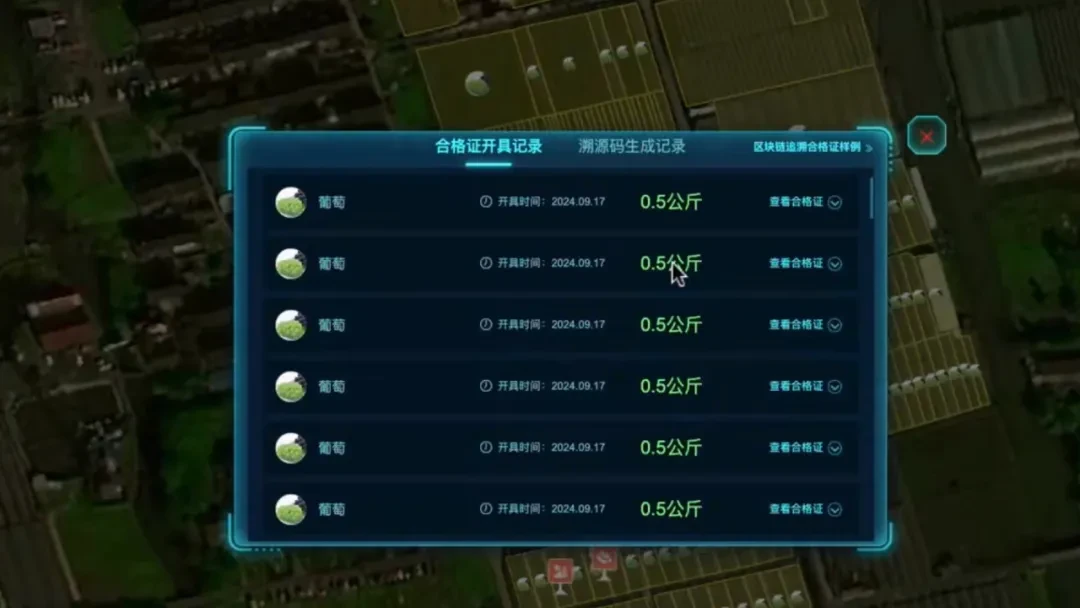The emergence of the pseudo RWA of Malu grapes: a dilemma of agricultural asset digitization under the compromise of loc
1 المقدمة
On November 25, 2024, the Shanghai Malu Grape Asset Chain Project was launched in a high-profile manner as the first case of Chinas agricultural RWA (real asset tokenization). The project claims to achieve vineyard data assetization through blockchain technology, and simultaneously completed 10 million yuan of equity financing and 200,000 yuan of NFT financing at the Shanghai Data تبادل. The official narrative shaped it into a benchmark for technology empowering real agriculture, triggering widespread heated discussions in the industry on the localization path of RWA.
However, stripping off the surface halo, the essence of this project is far from a true RWA innovation. The so-called tokenization is actually a reconstruction of traditional financing with NFT digital collections as a compliant shell and SPV equity structure as the core – the income right token is castrated, the governance right still belongs to the centralized entity, and the consumer NFT only serves as a pre-sale card. This de-financialization survival strategy, born under high regulatory pressure, has broken through in the name of technology, but has fallen into a deep dilemma of equity fragmentation, liquidity suppression and lack of producer empowerment.
This article will use the Malu Grape Project as an example to dissect the project and reveal three essential contradictions through its illusion of being a “RWA benchmark”:
-
Dilemma of technology instrumentalization: Blockchain has become a credit enhancement tool and has not touched upon the transformation of agricultural production relations;
-
Regulatory arbitrage logic: circumventing policy red lines through SPV equity isolation and NFT non-securitization تحديnition;
-
The cost of localization compromise: the right to data revenue is completely separated from producers (farmers), which deviates from the original intention of RWA to provide universal benefits.
By deconstructing the entire process from asset screening, on-chain mapping to financing design, this article will demonstrate that the core proposition of Chinas agricultural asset digitization is not technology replication, but how to balance compliance survival and real value creation under policy constraints. The paradoxical practice of Malu grapes provides a key mirror for exploring the limitations and possibilities of local RWA.

2. Process Disassembly
1. Asset screening and compliance confirmation
RWA refers to the tokenization of physical assets or financial assets in the real world through blockchain technology, enabling them to circulate, trade and manage in a decentralized network.
This requires the project party to screen the target assets before the project starts. On the one hand, it is to ensure that the asset attributes are suitable for tokenization, and on the other hand, it is to ensure the compliance of the assets in the real world:
-
Must be a real, valuable asset
-
Have stable cash flow or value-added potential
-
The ownership is clear and there is no dispute
Malu Grape is a Shanghai geographical indication agricultural product with a cultivation history of more than 40 years. It is deeply loved by consumers for its excellent quality and unique taste.
Data shows that in 2023, the concentrated planting area of Malu grapes has reached 4051.96 acres, with a total output of 4437.83 tons, a total output value of 107 million yuan, an average output value of 27,320 yuan per acre, and an average unit price of 24 yuan per kilogram. The planting area and economic benefits of Malu grapes occupy an important position in Shanghais grape industry, accounting for 12.9% of Shanghais grape planting area and 17.17% of the total economic benefits, respectively.
At present, Malu Town has formed an industrialized consortium development model of research institute + enterprise + cooperative + farmer. The research institute is responsible for the research and development and promotion of new varieties and new technologies, the enterprise is responsible for brand building and marketing, the cooperative is responsible for organizing farmers to carry out standardized production, and the farmers carry out planting and management according to requirements.
In terms of product quality, Malu grapes include more than 50 varieties, including Black, Xile, Jingmi, Kyoho, Giant Rose, Zuijinxiang, Sunshine Rose, Queen Nina, etc., and have formed a sound management system for field archives, testing and inspection, packaging labeling, quality traceability and logo use. In conjunction with the digital cloud platform, it has achieved one string and one code traceability management, which is an industry benchmark for digital agricultural production and has the asset conditions for RWA tokenization.
2. Technology packaging and on-chain mapping
One of the keys to the RWA project is to ensure the authenticity of off-chain data after it is uploaded to the chain, which is a decisive factor in the success of the RWA project.
(1) Data collection
During the Malu grape cultivation process, IoT devices are used to build a strict data collection network.
In terms of environmental data, environmental parameters such as temperature and humidity, light intensity, soil pH value, etc. are collected in real time during the grape planting process, and data on agricultural activities (such as irrigation and fertilization) are recorded.
In terms of economic data, sales data (such as sales volume, price), logistics information (transportation time, loss rate) and brand value (such as geographical indication certification, certification information, consumer reputation, etc.) are included in the asset package.

(2) Asset packaging
Integrate 300+ sensor data (soil pH, temperature and humidity, growth cycle, etc.) from 600 acres of vineyards to build a Data Asset Shell (DAS). DAS is an innovative Data Asset Shell service system launched by the Shanghai Data Exchange, which is responsible for data compliance certification and standardized processing. Unify data of different types and sources so that they can be integrated in an orderly manner on the chain, forming real data recognized by multiple parties on the chain (including growers, operators, regulators, investors, etc.), laying a solid foundation for subsequent asset valuation and transactions.
After the data is packaged, it is stored on the SwiftLink platform to ensure the credibility of the entire agricultural production process. Traceability uses blockchain technologies such as the SwiftLink management platform to instantly upload the collected massive data to the chain. The tamper-proof nature of the blockchain ensures that once the data is entered, it cannot be maliciously modified, ensuring the authenticity and integrity of the data.
On the other hand, the AMC (multi-chain same track) technology is used to synchronize data to the Shanghai Pujiang Digital Chain to achieve on-chain credit enhancement.

(3) Asset valuation
A comprehensive valuation of the integrated Malu Grape data assets was conducted using a variety of scientific methods.
The cost-plus method calculates a series of direct input costs, from data collection equipment investment, labor costs to data processing operations; the market premium method combines the premium performance of the Malu Grape geographical indication brand in the market to evaluate the additional value of the brand to the assets; the discounted income method predicts the increase in revenue brought about by data applications in the next few years, such as precise irrigation to reduce costs, traceability systems to reduce counterfeits and enhance brand value.
(4) رمز مميز model design
Based on the valuation results, the assets are converted into tradable digital tokens.
The project has designed a layered token economic model, with revenue rights tokens accounting for 70%, closely anchored to grape sales revenue, providing investors with an annualized benchmark dividend of about 6%, attracting stable investors such as bank wealth management funds;
Governance tokens account for 20%. With these tokens, holders have the right to vote on major decisions of the vineyard (such as the introduction of new varieties and the expansion of sales channels), attracting in-depth participation of industry investors;
Consumer rights tokens account for 10% and are bound to product discount rights. If you hold this token, you can enjoy a 20% discount on Malu grapes, which will increase the stickiness of C-end users and recover part of the sales funds in advance.

3. SPV structure and financing design
In October 2023, Shanghai Zuoan Xinhui Electronic Technology Co., Ltd. and Shanghai Zuoan Investment Management Co., Ltd. jointly invested 10 million yuan to establish Zuoan Xinhui (Shanghai) Data Technology Co., Ltd. as the projects exclusive SPV.
The SPV independently carries the Malu grape data asset package (including agricultural product production data and brand rights), which is completely isolated from other businesses of the parent company to avoid risk transmission.
100% of the SPV company’s equity is held in custody at the Shanghai Equity Custody and Registration Center and is stored on the blockchain platform “Guyi Chain” to achieve transparency of ownership.
This is where the project begins to undergo significant and interesting changes.
Since Malu Grape operates in the mainland and circulates in the Shanghai Data Exchange, according to mainland Chinas Notice on Preventing Token Issuance and Financing Risks (2017) and Initiative to Prevent NFT Financial Risks, mainland China prohibits the issuance of securitized tokens. In addition, Malu Grape did not finance and circulate according to the original token model in the end, but chose and sacrificed liquidity and took the de-financialization RWA route.
In actual operation, the consumer rights token is not presented in the form of a token, but as an NFT digital collectible, which is clearly defined as a digital souvenir to avoid the red line of the Notice on Preventing the Risk of Token Issuance and Financing. Finally, 2024 NFTs were issued (including 1924 basic models and 100 scarce models), 2013 were publicly sold (accounting for 99.3%), and the project party retained 11 (for brand cooperation or airdrops), with an initial price of 99 yuan per piece. As a result, the Malu Grape Project NFT completed a financing of 200,000 yuan.
Next, the governance rights belong to the project party, and the income rights belong to the investors. The income rights and governance rights are integrated into the SPV equity structure, which is only open to institutions. Malu Grape received 10 million yuan in financing from investors. The 10 million yuan financing is based on SPV equity transactions. Investors indirectly control the income rights of data assets through shareholding, which is in line with the regulatory framework of the Securities Law on equity transactions.

4. إدارة السيولة
(1) Issuance
On November 25, 2024, the Malu Grape NFT digital collection was publicly issued on the Shanghai Data Exchange. It was quickly sold out after the issuance and is currently only traded in the secondary market.
Each NFT consists of two layers: basic rights and subsidiary rights:
Basic benefits: including 1924 basic NFTs and 100 rare NFTs. The basic NFTs can get a pick-up card for 2 kg of Sunshine Rose grapes, worth about 200 yuan, valid until December 8, 2025; the rare NFTs can get a pick-up card for 2 kg of Queen Nina grapes + 2 tickets to Malu Park, worth about 300 yuan, valid for the same period as the basic NFTs.
Subsidiary benefits: You can access the Malu Planet interactive platform, participate in the virtual grape planting game, and redeem points. The top 50 users in terms of transaction volume before December 31, 2024 will receive an additional early variety pick-up card.

(2) Circulation mechanism
Trading restrictions: Trading is limited to December 9, 2024 to December 8, 2025, and forced delisting upon expiration; single user holdings ≤ 5% of the total issuance (about 101), exceeding the limit requires split sales; after a single sale, you must wait for 5 trading days before trading again
Cancellation and withdrawal: After the pick-up card is activated, the NFT chain is cancelled and only the platform interaction qualification is retained; if the vineyard is damaged (such as fire), the project party has not disclosed the compensation plan, and there is a loophole in the protection of rights and interests.
(3) سوق performance

3. Power Map
The tokenization of real assets is a capital operation that requires the participation and collaboration of multiple parties. Below, from the perspective of the participants, we will sort out the various participants and their main responsibilities in the Malu Grape project, and re-examine the project value of Malu Grape from a global perspective.
We can divide the participants into two categories: core participants and supporting institutions.
1. Core participants
Zuoan Xinhui (project operator) is responsible for integrating grape production data and brand qualifications, issuing NFT digital assets, and managing equity financing funds. It is a core participant in the entire project.
The Shanghai Data Exchange (compliant trading platform) is responsible for providing Data Asset Shell (DAS) on-chain evidence storage services, building NFT trading channels, and ensuring compliance with information disclosure.
Malu Town Economic Development Service Center (government coordinator) is responsible for policy endorsement and resource matching.
Malu Grape planting enterprises (underlying asset providers): provide grape physical assets and generate agricultural data.

2. Supporting organizations
Technical infrastructure service provider: Provides underlying blockchain technology support to enable data storage on the chain.
Compliance and risk control agencies: design compliance frameworks and audit the authenticity of real assets.
Asset appraisal agency: asset pricing.
Equity custodian: record and manage the equity of the SPV company to ensure transparency of equity transactions.

After the above analysis of the functions of each participant, we can see that the structure of the participating entities of the Malu Grape RWA project is essentially a market-oriented co-governance experiment under the guidance of the government. Through the triple nesting of state-owned asset chain (Pujiang Digital Chain) + SPV + parent and child brands, it not only ensures compliance (avoids securitization risks) but also activates the efficiency of the industrial chain (the per mu output value reaches 1.7 times the Shanghai average). It is a complex economic activity that requires coordination among multiple parties and full mobilization of production factors.

4. The root cause: How the three characteristics of pseudo-RWA anchor the localization dilemma
Therefore, through the dismantling of the Malu Grape Project, we can find a fact. Different from what some propaganda said, Malu Grape is not a real RWA project, for the following reasons:
The tokenized assets of a typical RWA project represent the corresponding share of profits. They can also be freely circulated around the world and automatically distributed as dividends through smart contracts.
As defined by RWA, Real World Asset refers to the tokenization of physical assets or financial assets in the real world through blockchain technology, so that they can be circulated, traded and managed in a decentralized network.
In contrast, the Malu Grape Project, 2024 NFTs are strictly defined as digital collectibles, which only bind consumer rights and anchor the ownership of future grapes, and do not involve future potential income. At the same time, strict restrictions are imposed on liquidity, which is essentially a pre-sale of agricultural products.
From the perspective of the ownership of income rights, NFT holders only receive grape pick-up cards (worth 200-300 yuan) and game points, and cannot share the data asset income. The income belongs entirely to the SPV shareholders, and the data income is completely separated from the users. The project party claims token-bound income dividends, but in fact the income rights are completely isolated from the NFT holders through the SPV equity structure.
From the perspective of governance rights, whether it is the introduction of new products or technological upgrades, it is still controlled by the SPV company, the local government (Malu Town Economic Service Center), and the technical party (Ant Chain). It is not open to public voting. On-chain governance is actually an internal decision-making tool of the SPV, which runs counter to the concept of DAO.

In summary, the essence of Shanghai Malu Grape RWA is a capital operation with NTF as a compliance shell and equity financing as the core value. It is a chain shell + traditional financial core. The technology only serves to enhance credit rather than liberalize it. It is a Chinese-style RWA project with high government participation.
On the one hand, we should face up to the correct positioning of the project (its essence is equity financing). On the other hand, we should also see the duality of the project, namely, the compromise and concession under compliance pressure, and the technological innovation opened up in the cracks. This has pioneering reference significance for exploring RWA projects in the current agricultural field in mainland China.
5. Breaking the Wall Experiment: A Step-by-Step Path from Real Compromise to Ideal Reconstruction
The duality of the Malu project – compromising technology in exchange for survival under regulatory constraints, but sacrificing the core value of RWA – reflects the deep dilemma of Chinas agricultural asset digitization: when compliance survival squeezes out real innovation, what is the way out? If its SPV isolation technique and NFT de-financialization path are copied, it will fall into a cycle of dependence on policy privileges and lack of producer empowerment; if it returns to the true RWA path, it will have to face three shackles: policy repression, technical cost, and non-standard equity distribution. The following breakout experiment may be a gap in the iron curtain.
1. Analysis of project promotion difficulty
The core value of the Malu Grape Project is that it has pioneered a localized path for agricultural RWA, but its promotion faces three structural obstacles:
(1) The non-replicability of policy reliance
The project relies heavily on Shanghai Pujiang Data Chain (state-owned asset alliance chain) and the government coordination mechanism, but most agricultural areas in the country lack such infrastructure support. For example, it is difficult for non-pilot areas to obtain compliance endorsements from data exchanges, and the policy red line of prohibiting homogeneous token transactions in the mainland forces other agricultural companies to follow its consumer NFT compromise solution and fail to achieve true opening of income rights.
(2) Scale threshold of technology cost
More than 300 IoT sensors are deployed in the 600-mu core area, with an average equipment investment of more than 20,000 yuan per mu, far exceeding the affordability of small and medium-sized farmers. The premium rate of ordinary agricultural products (such as Chinese cabbage) is less than 5%, which cannot cover the cost, while Malu grapes rely on the 20% brand premium of geographical indications to achieve break-even. If it is promoted to low value-added categories, it is necessary for the region to jointly build and share IoT platforms (such as county agricultural clouds), but cross-subject data integration faces ownership disputes.
(3) Industry limitations of asset standardization
Grapes are easy to standardize due to the one bunch, one code traceability and production control, but tea, aquatic products and other categories lack unified data collection standards. For example, the quality of tea is affected by subjective factors such as microclimate and picking techniques, making it difficult to generate a trusted data package on the chain, resulting in a lack of consensus basis for asset valuation.
(4) Essential Contradiction
The Malu model is actually a special case of strong policy area + high premium products, and its technology dividend is only applicable to scarce agricultural products such as Wuchang rice and Yangcheng Lake hairy crabs. Replication in ordinary agricultural areas requires breaking through the cost constraints and data property rights distribution dilemma – the EU stipulates that the original data producers (farmers) should enjoy 40% of the income rights, while the 27 cooperatives in the Malu project only serve as data providers and do not participate in SPV dividends.
2. Conditions for the realization of the complete form of RWA
(1) Asset securitization compliance first
Avoid the mainlands regulatory minefields and choose jurisdictions such as Hong Kong/Singapore that recognize income rights tokens. The underlying assets must have stable cash flow (such as annual income of charging piles > 30 million yuan), pass the approval of the CSRC No. 1 license, and disclose asset audit reports. Because the grape income of the Malu project is affected by climate fluctuations, it is forced to replace the hard-core cash flow with data value-added potential, which weakens the credibility of asset anchoring.
(2) Technology penetration design
Oracles (such as Chainlink) are used to verify the status of off-chain assets in real time to ensure that the value of tokens is strongly associated with physical assets. In contrast, Malu only stores environmental data on the Pujiang Digital Chain, and does not automatically upload revenue to the chain, so its NFT holders cannot obtain dividends through smart contracts. A true RWA needs to deploy the ERC-3643 standard contract (including a dividend module) to support automatic allocation of daily revenue to wallets.
(3) Two-layer construction of liquidity
The primary market is privately sold to qualified investors through licensed exchanges (such as Hong Kong HashKey); the secondary market is connected to DEX such as Uniswap, and the trading depth is guaranteed by market makers. In contrast, Malu NFT is limited to trading on the Shanghai Digital Exchange platform, with an average daily trading volume of less than 10 transactions, and is forced to be delisted in 2025, artificially suppressing liquidity.
(4) Critical transition
A true RWA needs to complete the cross-border split of domestic assets + overseas financial end. The QFLP channel of Hainan Free Trade Port can be used as a springboard – the domestic state-owned asset chain stores asset ownership, and the overseas SPV issues revenue tokens, so as to balance compliance and capital freedom.
3. Future prospects of agricultural RWA 4.0
The current Malu project is stagnant at stage B (assets are divisible but not circulated) and requires the Hong Kong/Hainan sandbox to achieve a transition from C to D. The development of agricultural RWA needs to break through institutional and technological bottlenecks in stages, with the ultimate goal of achieving the return of producer sovereignty.
(1) Short term: Equity mixing experiment in the sandbox
In pilot areas such as Hainan and Hengqin, a hybrid model of consumption-type NFT + micro-income rights is implemented, with an annualized income cap of 3% to comply with the regulatory standards for consumer rebates. For example, the Hainan durian project plans to return 1.5% of the picking income to NFT holders through smart contracts, which not only avoids securitization certification but also improves user stickiness. At the same time, an agricultural data bank was established to support loans pledged with planting data in tea gardens and rice fields, replicating the 1.5 million yuan bank credit model of the Malu project.
(2) Medium term: Breakthrough in data property rights legislation
Promote the release of the Regulations on the Registration and Management of Agricultural Data Assets to clarify the three-party rights confirmation ratio: farmers account for 40% of the original data income (as providers of means of production), cooperatives account for 30% (data integrators), and technology platforms/governments account for 30% (infrastructure investment and regulatory costs). Through on-chain evidence storage, the ownership division rules are solidified to solve the pain point of lack of governance rights of small and medium-sized farmers in the Malu project.
(3) Long term: Producer sovereignty under DAO governance
Constructing a cooperative model on the chain: farmers obtain voting weights based on their land data contribution, and consumers participate in the decision-making of variety introduction with governance tokens. For example, when the Internet of Things monitors that the drought resistance of a certain grape variety has increased by 15%, the DAO votes to expand the planting area, and the smart contract automatically adjusts the production plan and distributes the benefits. This architecture makes the code a new era hoe and rebuilds the subjectivity of small farmers in the digital economy.
(4) The core of the Chinese paradigm
The ultimate value of agricultural RWA lies in global technology and local reconstruction of production relations. In the short term, we will accept the transition of consumer NFTs, and in the long term, we will enable farmers to master the data pricing power through on-chain cooperatives (DAOs), so that producers in the fields can truly become the primary distributors of digital dividends.
سادسا. الخاتمة
The essence of the Malu Grape Project is a revolution with shackles. When the distributed ideal of blockchain encounters the iron wall of real supervision, it chooses to retreat to advance: using the compliant shell of consumer NFT to cover the real breakthrough of the Internet of Things and traceability technology, and using the tiny leverage of 200,000 digital delivery certificates to leverage the industrial upgrade of 10 million equity financing. This dialectic of compromise and innovation is like a seed growing in the cracks of a rock: bending down is not to yield, but to accumulate strength to break through the ground.
The real legacy of the Malu Grape Project is that it provides a dialectical model for the digitalization of Chinese agriculture:
-
It proves that under high-pressure regulation, consumer NFT is the only safe entry point, and the opening of income rights needs to go through offshore hubs (such as the Hainan QFLP channel);
-
It reveals that IoT+blockchain can achieve “asset separability”, but “capital accessibility” depends on breakthroughs in cross-border liquidity;
-
It shows that the end point of RWA should be the awakening of producer sovereignty. When farmers master the data pricing power through DAO, technological innovation can truly become the engine of rural revitalization.
The core proposition of agricultural modernization has never been the replication of technology, but the reconstruction of production relations. All atypical RWA are shadows cast by the times. The compromise and breakthrough of Malu grapes are like a seed buried deep in the soil – it may not be able to grow tall, but with its curved posture, it marks the direction for later generations to break out of the ground.
This article is sourced from the internet: The emergence of the pseudo RWA of Malu grapes: a dilemma of agricultural asset digitization under the compromise of localization
Original author: Weilin, PANews While reaching a settlement with the U.S. Securities and Exchange Commission (SEC), Ripple is rapidly restarting its global expansion in the Middle East, with Dubai becoming a key landing point for its layout of tokenized real-world assets (RWA). Recently, the Ripple-backed blockchain XRP Ledger was selected as the underlying blockchain network for Dubai’s real estate blockchain tokenization project, showing that Ripple and XRP’s development in government-enterprise cooperation, cross-border settlement and stablecoin infrastructure is gradually turning into a breakthrough business direction for the company. At the same time, on May 29, Nasdaq-listed energy company VivoPower International announced the completion of a $121 million private placement financing, and will transform into a crypto asset reserve strategy centered on XRP. Saudi Prince Abdulaziz bin Turki Abdulaziz Al Saud led…






